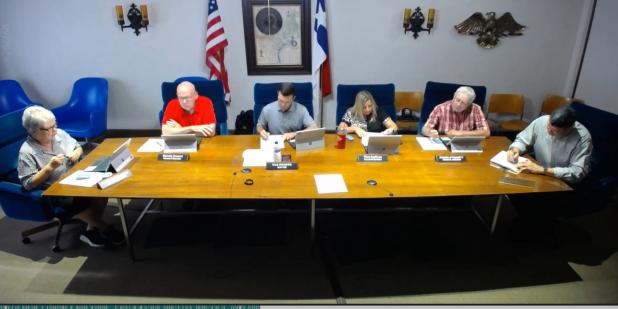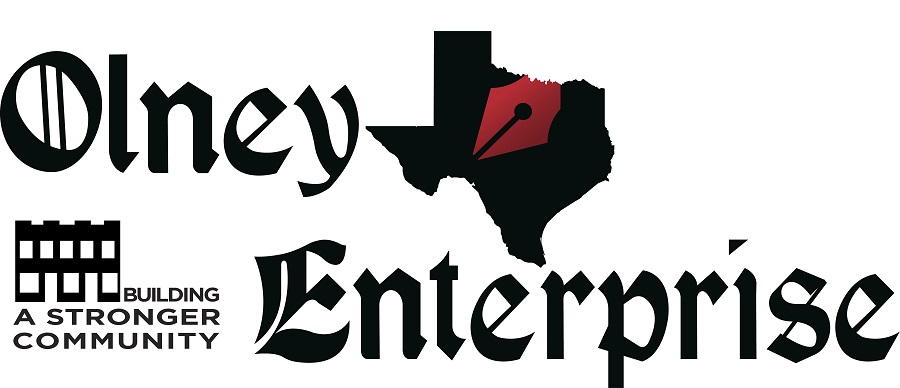
Water plant ideas aired at Town Hall
The Olney City Council will vote to rebid the water treatment plant construction project and explore ways to finance an expected shortfall following a July 10 town hall meeting that explored ways to resurrect the stalled project.
The Council will vote on whether to rebid the project on the Council’s July 22 agenda.
Rebidding the project through architects Corlett Probst & Boyd of Wichita Falls would take 45 to 60 days and cost a couple of thousand dollars, Mayor Rue Rogers said. The winning bidder could break ground in as little as six months, he said. Construction on the new plant is expected to take 600 days to two years, he said.
The Council and a few citizens heard proposals by City Administrator Simon Dwyer for how to bridge a funding gap that could reach several million dollars. The City sold $13.5 million in revenue bonds in April of 2022 to replace the existing 102-year-old plant, whose concrete works are crumbling, Mayor Rogers said.
The lowest bid for the plant, designed by Corlett Probst & Boyd and approved by the Texas Commissioner on Environmental Quality, came in last November at $15.3 million for a “base” bid and $16.6 million for an “add-on” bid for a plant with the concrete clearwells the Council and Public Works Director Michael Jacoba preferred.
The Council rejected the low bid and went back to the drawing board. Four members – Tom Parker, Harrison Wellman, Brad Simmons, and Tommy Kimbro – have since left the Council.
The new members – Thea Sullivan, Ronnie Cowart, and Terri Wipperman - agreed after the 90-minute meeting to rebid the project to get a hard number for the shortfall, and start construction as quickly as possible while searching for new funding to cover the gap.
Mr. Dwyer told the Council that the City loses at least $50,000 worth of buying power every month it delays starting the project. The City also could be forced to repair or replace the plant at a higher cost by the Texas Commission on Environmental Quality if water quality falls below state standards, he said.
The Council also questioned Jake Lawrence, the City’s financial advisor from Government Capital Securities, about ways to fund the shortfall.
Mr. Dwyer presented four options: first, hiring a construction manager- agent [CMA] to manage the project and try to get cheaper bids from subcontractors; second, approaching the City’s largest water customers such as Tower Extrusions and Air Tractor to agree to pay for up to 10 years’ worth of water upfront in a “tax anticipation note”; third, rebidding the project and accepting the lowest basic bid and add on the concrete clearwells through change orders when funding comes in; and lastly, “go with the bids that have all the stuff we want,” Mr. Dwyer said.
While hiring a CMA could save substantial money, that option would shift liability and day-today oversight to the City to ensure the project meets TCEQ standards, Mr. Dwyer said.
Councilmember Thea Sullivan, an auditor and accountant for school districts, said hiring a CMA “is a massive undertaking in accounting” for the City staff, “whereas the other way [with a general contractor supervised by Corlett Probst & Boyd], they will send you one bill a month – easy to trace, fraud is very low because they monitor all that.”
Mayor Rogers, who works at Tower, said he would speak to Tower and Air Tractor about the tax anticipation note.
The third option - to begin construction while seeking additional funding - garnered the most support after Mr. Lawrence explained that the City had at least a couple of years to find more funding.
Mr. Lawrence said Olney’s predicament “is not uncommon in the current inflationary environment.” He said Olney could issue parity bonds to a private bank or investor to pay the difference between the bond funds and the overage until USDA funds or other grants come into the City’s coffers.
He also said Olney’s water rates are lower than other small cities, and having room to raise rates could reassure investors and fund additional borrowing.
“You can pay as you go,” Mr. Lawrence said. “It’s in the meat of the second year that you start writing the big checks. You don’t have to have the funding right now.”
Ms. Hourigan noted that revenue from the City’s $35-per-meter surcharge has covered the debt payments on the revenue bonds.
The final option – going ahead with the fullprice plant – “is problematic because the City could be on the hook for more than it can come up with,” Mr. Dwyer said.
The City of Olney is in the process of applying for USDA grants and loans that could bring in as much as $1.2 million toward the water plant, Mr. Dwyer said. The City meets the requirements for low-income and economically for the water plant that could total as much as $1.2 million for and meets the qualifications but may not receive that funding for several years, Mr. Dwyer said.
